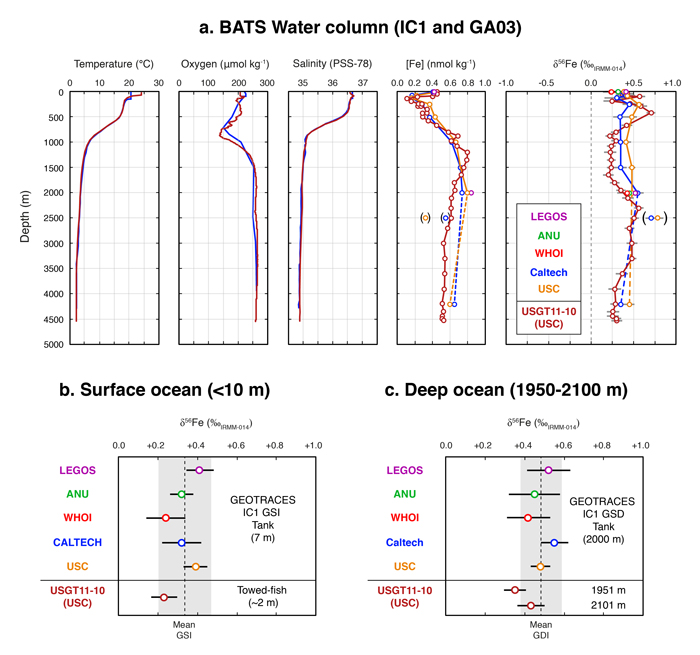An example of a fruitful international intercomparison
The reliability of the GEOTRACES data products including the eGEOTRACES Electronic Atlas is strongly related to the quality of the data acquired by the different laboratories contributing to this international effort. A key aspect for assessing this quality relies on the good intercomparison of the trace metal data. Iron (Fe) concentrations and moreover Fe isotopes count among the most delicate parameters to be measured in seawater.
Conway (Switzerland), John (USA) and Lacan (France) (2016, see reference below) present the first comparison of dissolved Fe stable isotope ratio profiles in the oceans, analyzed at different depths at 3 different GEOTRACES crossover stations in the Atlantic Ocean (Bermuda Atlantic Time Series Station, off Cape Verde and in the Cape Basin, south Atlantic).
Having assessed the strong agreement between data and profiles measured by 5 different laboratories at Bermuda Atlantic Time Series (BATS), the authors discuss the temporal variability observed at the three locations, taking advantage of reoccupation of the stations by multiple cruises on a 1-3 year timescale. The authors find that the deep ocean at these locations is largely invariant for Fe isotopes on these timescales, but that there is variability in surface waters and near low-oxygen margins.

References:
Conway, T. M., John, S. G., & Lacan, F. (2016). Intercomparison of dissolved iron isotope profiles from reoccupation of three GEOTRACES stations in the Atlantic Ocean. Marine Chemistry. doi:10.1016/j.marchem.2016.04.007
Figure references:
Boyle et al., 2012: E.A. Boyle, S.G. John, W. Abouchami, J.F. Adkins, Y. Echegoyen-Sanz, M.J. Ellwood, A.R. Flegal, K. Fornace, C. Gallon, S. Galer, M. Gault-Ringold, F. Lacan, A. Radic, M. Rehkämper, O. Rouxel, Y. Sohrin, C. Stirling, C. Thompson, D. Vance, Z. Xue, Y. Yhao. GEOTRACES IC1 (BATS) contamination-prone trace element isotopes Cd, Fe, Pb, Zn, Cu, and Mo intercalibration. Limnol. Oceanogr. Methods, 10 (2012), pp. 653–665. doi: 10.4319/lom.2012.10.653
Conway and John, 2014a: T.M. Conway, S.G. John. Quantification of dissolved iron sources to the North Atlantic Ocean Nature, 511 (2014), pp. 212–215. doi: 10.1038/nature13482
Conway et al., 2013a: T.M. Conway, A.D. Rosenberg, J.F. Adkins, S.G. John. A new method for precise determination of iron, zinc and cadmium stable isotope ratios in seawater by double-spike mass spectrometry Anal. Chim. Acta, 793 (2013), pp. 44–52. doi: 10.1016/j.aca.2013.07.025
Conway et al., 2013b: T.M. Conway, A.D. Rosenberg, J.F. Adkins, S.G. John. Corrigendum to “A new method for precise determination of iron, zinc and cadmium stable isotope ratios in seawater by double-spike mass spectrometry.” Anal. Chim. Acta, 801 (97) (2013). doi: 10.1016/j.aca.2013.09.010
John and Adkins, 2012: S.G. John, J.F. Adkins. The vertical distribution of iron stable isotopes in the North Atlantic near Bermuda Glob. Biogeochem. Cycles, 26 (2) (2012) doi: 10.1029/2011GB004043
